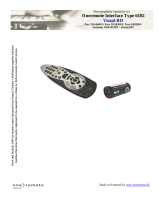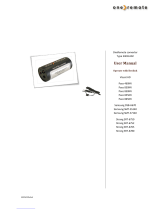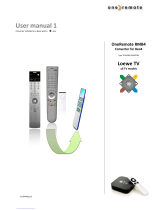Page is loading ...

Beocompatible Operation via
Oneremote Interface Type 6124
Sony Flat screen TV
RM-ED009 / RM-ED010 / RM-ED011 / RM-ED012 / RM-ED013
Beo4 and Beolink 1000 are remote control terminals from Bang & Olufsen. OneRemote supplies interface
modules that allow third party equipment to be operated via a Bang & Olufsen remote control system.
Made in Denmark by
www.oneremote.dk
6124UKu1

Operating with Beo4 and Beo5
Beo4 and Beo5 do not have as many keys
as this TV’s original remote control. Thus
certain Beo4/ Beo5 keys have got
alternative functionality.
To get to this
Ohas to be pressed first,
i.e.
Ofollowed by 0on corresponds
to info on the TV’s own remote control.
The table to the right shows how special
Beo4/ Beo5 key operations translate to
operations of the original remote control.
To get the most of operating the TV with a
Bang & Olufsen remote control, the user
has to be familiar with operations with the
original remote control as described in the
TV’s user manual.
Power on the TV
The TV automatically powers up, when the
source is pressed on beo4, which the bee2
controller is programmed for.
Usually this source will be
t.
*1 It is possible to exchange the up/ down arrow the
functions with the blue and yellow buttons. This is
done with an option, refer to the installation pages.
*2 As the direct function of the coloured buttons on
the Beolink remote control has been reassigned to
other functions, Ohas to be pressed before these
buttons, to get to the colour function.
oE Red function
oQ Green Function
oW Yellow function
oR Blue function
Beo4/ Beo5 Daily operation
OO OK
o1 Analog
o2 Digital
W
*2 *1 P+
R
*2 *1 P-
Q
*2 Guide
E*2 Return
m
Home
om Options
e
Back
w Power off
Other operation
q Format
o0 i+
o3 FAV
o4 Subtitle
o6 AV
o7 Audio

Congratulations
With your bee2 controller from
www.oneremote.dk you now
can fully operate your Sony TV using your Bang & Olufsen
remote control terminal, via a beeLINK system bus.
Beolink1000, Beo4 or Beo5 remote controls can be used. This
guide explains how.
This BeeLINK2 controller is ready for use, plug & play. See the
opposite page regarding daily operation.
Some operations can be altered, to improve interaction with
other controllers or to your convenience. Refer to the installation
section further on, if changes are needed.

BeeLINK - How it works
The OneRemote beeLINK system is based on a 455 khz IR-receiver placed in the room.
Via a beeLINK amplifier it can distribute control data to many different beeLINK
controllers or BeeLINK compatible devices, each designed for a specific purpose. One
controller is used for the TV, another controller for the DVD, a third for a beamer and so
on.
The BeeLINK system lets you control many devices, in a logic way. A single press on the
DTV button on the Beo4 might operate the TV, a receiver, an amplifier and a HDMI
switch at the same time. There are many solutions.
The beo4 remote control is not equipped with as many keys, so we have designed a
‘layout’ that works logically, even when shifting between different devices. To get a
common layout for many devices, we therefore needed to redefine a few of the beo4/ beo5
buttons to other functions:
• Coloured buttons.
To make room for more important functions, we have moved the coloured
buttons, to a lower layer. To send a ‘red’ button command
O must be pressed
first. The same goes with the other 3 coloured buttons. This way we can assign
other functions to the coloured buttons, when pressed, without a preceding go. In
a OneRemote environment the red button is used as Back, Backup or return. The
green button is used as EPG, Guide or similar. Finally the blue and yellow button
is used for programme stepping.
• Programme stepping, up/ down manoeuvring in menu’s.
Most set top boxes and TV’s has 4 arrow buttons for moving up, down, left and
right, in on screen menus. In addition they have separate programme stepping
buttons for zapping through programmes. B&O remote controls do not include
separate buttons for programme zapping.
We therefore have assigned the blue and the yellow buttons to function as
programme stepping buttons, in our basic setup. The four up, down, left and right
buttons have been assigned for manoeuvring in on screen menus, in our basic
setup.
It is possible to use the up and down arrow for programme stepping, refer to the
installation section.
• Go or Record shifted operation.
Some of the buttons has 2 or three functions. To get to these they have to be
preceded with O or r. Which buttons has secondary functions can be
seen in the operating table on page 2.

BeeLINK basics – the link amplifier.
To receive the IR data emitted from a Bang & Olufsen remote control, a B&O IR-receiver
is often used. If there is already one IR-receiver in the room, this can also be used to feed
the BeeLINK bus. Normally there is no need for two IR receivers in the same room.
A Bang & Olufsen IR-receiver connected
to the BeeLINK link amplifier with four
BeeLINK outputs.
Four BeeLINK controllers can be
connected to this link amplifier. One or
more BeeLINK splitters can be inserted
to add outputs for more controllers.
The shown 700mA power supply is
capable of driving the IR-receiver, the
link amplifier and up to 15 attached
BeeLINK controllers.
This basic setup is the core of a BeeLINK installation. Up to four BeeLINK controllers or
BeeLINK compatible devices can be connected to this linkamplifier.
BeeLINK basics – the distribution of power and data.
The BeeLINK bus distributes the IR-data, received with the attached IR-receiver. It also
distributes 12 volt power from the attached power supply.
The cable used is ordinary CAT5 type cable with RJ45 plugs. The same type used for
computer network. We chose this type for several reasons. This cable is inexpensive and
easy to crimp plugs on, with inexpensive tools. Also it is well suited for data transmission,
and it provides us with extra leads for power supplying of the attached BeeLINK
controllers. Finally many modern house installations use the same connectors, making
installation even easier.
Note !
A BeeLINK bus must ONLY be connected to BeeLINK components.
If connected to LAN or other systems,
there is a great risk to damage these systems.

The BeeLINK bus is a parallel bus type. Passive splitters therefore can be used, to make a
network of any shape. If many controllers or very long cables are used, it might be
necessary to place one more or more power supplies, placed closer to the controllers that
lack power.
Using this parallel structure each BeeLINK controller receives the IR-data at the same
time. Every controller has its own microcomputer, living its own life.
Although some of the controllers can ‘talk’ to each other, most controllers operate fully on
their own.
BeeLINK2 – installation
The BeeLINK2 controller gets its power supply and control data, via the CAT5 cable
from a BeeLINK amplifier.
Once connected to the BeeBus the BeeLINK2 controller only needs an IR-emitter to
operate the TV. The IR-emitter emits the same IR data as the TVs own remote control.
Emitted IR data is in fact light at a frequency just out of the spectrum that the human eye is able to see.
It is short flashes of light, a bit like when sending morse codes using a flashlight.
The emitter must be stuck on the TV, nearby the TVs IR-receiver. It must be placed so the
IR receiver in the TV is able to see the emitted light from the IR-emitter.
The IR-emitter can be placed inside the TV, if you want to avoid having it on the outside,
as long as the IR-receiver is able to see the light from the emitter.
A BeeLINK2 controller connects to the
BeeBUS via a CAT5 cable, for power supply
and control data.
A IR-emitter sends the commands to the TV.
The BeeLINK2 controller can be placed by the TV or in another room. IR emitters are
available in lengths of 1, 5 and 10 meters. In addition extension cords can be used. An IR-
emitter can be extended to more than 30 meters.
The BeeBUS CAT5 cable can be more than 75 meters.

BeeLINK2 connections.
The IR/ sense socket is output for the IR-emitter that sends IR to the device to be
operated. In some cases this socket is also used for sensing purposes. Often the BeeLINK2
controller needs to know if the device is powered up or not. In some cases this socket is
used for other serial communication like RS-232.
Prog switch is a push button that must be activated to initiate a programming sequence, as
described in the option programming chapters.
Do not use socket is for firmware updating of the controller. If used for anything else, the
controller can be damaged.
LED indicates different operating modes:
Red-green flash: No data has been received since power has been applied
Red flash: The controller is in option programming mode.
Red: The controller is active.
Green: The controller is inactive.
A BeeLINK2 controller connects to the BeeBUS via a RJ45
connector and CAT5 cable.
Warning:
If connected to a computer network,
this is likely to be damaged.
Connect only to a BeeLINK bus.

BeeLINK Active option.
As all controllers on the BeeLINK bus are receiving all the IR-data at the same time,
every controller must know when to go active and when to go inactive. Sometimes two or
more controllers are active at the same time.
A BeeLINK 2 controller is used to operate a TV, a satellite receiver, a DVD-player, a
projector or similar devices. Each controller is specifically made for one device.
This BeeLINK 2 controller is made for operating a TV; therefore it would be logic if the
TV button makes the controller go active and turns on the TV. Any other source button
could be used, if this is required.
Your BeeLINK2 controller needs to know when you want it to go active, in your setup.
You need to program it with an option.
An option programming sequence is started by pressing the little red switch on the
BeeLINK2 controller, until its LED starts flashing. Then the 3 code option must be
entered with the B&O remote control. Here some examples:
Option Function
t0r t turns on the TV.
t1r t + 1 turns on the TV.
t2r t + 2 turns on the TV.
Up to 10 TV’s or projectors can be controlled this way. This could be useful for a TV wall
in a shop, but also useful if there is more than one TV or projector in the room.
When the BeeLINK2 controller goes active, its LED will turn red to indicate this. When
another source is selected, the controller will go inactive and the LED turn green.
As the controller goes active, it will turn on the TV, if it is not already turned on.

BeeLINK source option.
The BeeLINK active option sets which source button on the remote control, that makes
the BeeLINK2 go active and turns on the TV, as described in the previous chapter.
The BeeLINK source option combines other source buttons on the remote control, with
the input sockets on the TV. The source option can force the TV to open a specific input,
when another source is selected.
Pioneer TVs have up to 9 selectable sources, as shown in this table:
0: No new source
1: HDMI 1 4: HDMI 4 7: Video 3
2: HDMI 2 5: Video 1 8: Component 1
3: HDMI 3 6: Video 2 9: Component 2
Source buttons on beo4, like s, T, f,c,y can be programmed to
select one of these inputs. Here are some programming examples:
An option programming sequence is started by pressing the little red switch on the
BeeLINK2 controller, until its LED starts flashing. Then the 3 code option must be
entered with the B&O remote control. Here some examples:
Beo4 Source Volume Function
T1 0 T
selects HDMI 1 on the TV. No volume regulation on TV
T2 0 T
selects HDMI 2 on the TV. No volume regulation on TV
T1 1 T selects HDMI 1 on the TV. Volume regulation on TV
d2 0 d selects HDMI 2 on the TV. No volume regulation on TV
d9 0 d
selects Component on the TV. No volume regulation on TV
c 1 0 c selects HDMI 1 on the TV. No volume regulation on TV

Programme Zapping option
The buttonsW , R,D and Fare being used for programme stepping
and to manoeuvre up and down in an on screen menu.
This is the basic OneRemote layout and compatible with other OneRemote controllers.
Some people prefer the programme zapping buttons on the up and down buttons. The
programme zapping option, make it possible to change the function of these buttons.
An option programming sequence is started by pressing the little red switch on the BeeLINK2 controller, until its
LED starts flashing. Then the 3 digit option code must be entered with the B&O remote control.
Option Function
090 W and R is used for programme zapping.
091 D and Fis used for programme zapping. Factory setting.
Volume option
In a setup that includes a surround sound system, volume regulation needs to be avoided
on the TV. This can be done with the volume option.
An option programming sequence is started by pressing the little red switch on the BeeLINK2 controller, until its
LED starts flashing. Then the 3 digit option code must be entered with the B&O remote control.
Option Function
000 Volume regulation on the TV disabled.
001 Volume regulation on the TV enabled. Factory setting.


/



